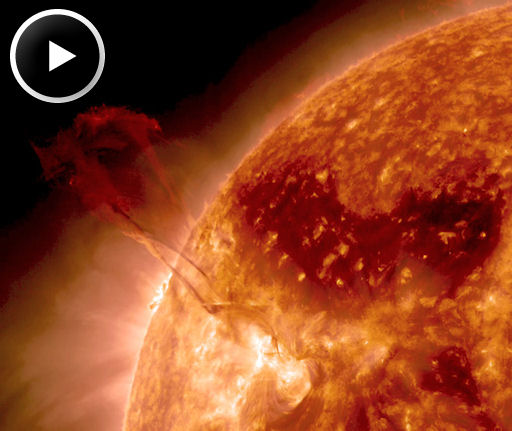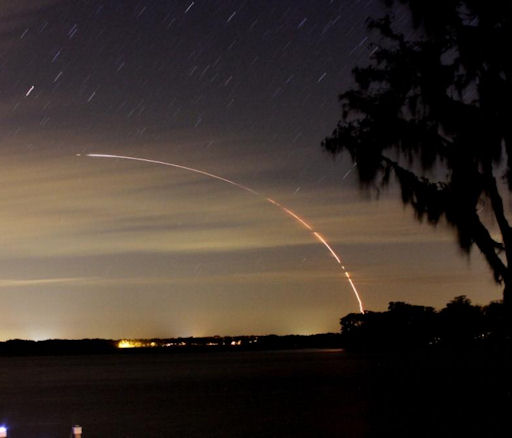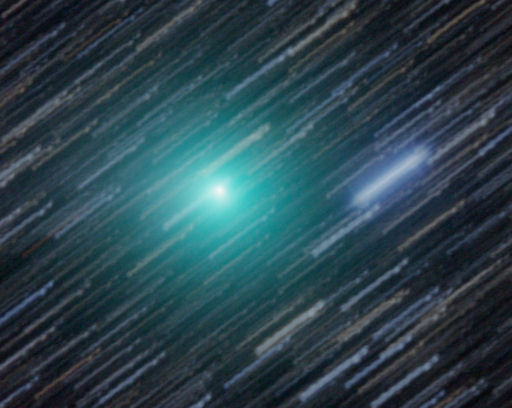Metallic photos of the sun by renowned photographer Greg Piepol bring together the best of art and science. Buy one or a whole set. They make a stellar gift. | | |
RECORD-SETTING ASTEROID FLYBY: On Feb. 15th an asteroid about half the size of a football field will fly past Earth closer than many man-made satellites. Since regular sky surveys began in the 1990s, astronomers have never seen an object so big come so close to our planet. [full story] [video]
ERUPTING MAGNETIC FILAMENT: As expected, an unstable filament of magnetism curling over the sun's northeastern limb erupted today. NASA's Solar Dynamics Observatory recorded the blast at approximately 0515 UT on Jan. 31st:

Despite the obvious energy of the blast, very little of the filament actually flew into space. The sun's gravity pulled most of the debris back to the stellar surface. So this eruption was primarily photogenic, not geoeffective.
Elsewhere on the sun, no sunspots are actively flaring. NOAA forecasters estimate a slim 1% chance of M-class or X-class solar flares during the next 24 hours. Solar flare alerts: text, voice.
Realtime Space Weather Photo Gallery
SPACE COMSAT LAUNCH: Last night, NASA launched a new communications satellite to shore up the space agency's Tracking and Data Relay System for high-bandwidth missions such as the International Space Station and the Hubble Space Telescope. Mark Staples photographed the lift-off from Little Lake Santa Fe in Waldo, Florida:

"I was 150 miles from the launch site in Cape Canaveral," says Staples, "but the view of the bright orange flame was surprisingly clear. Launches are always exciting no matter how close or far away I am."
This comsat, named TDRS-K, was the first of three next-generation satellites NASA plans to add to the existing fleet. "With this launch, NASA has begun the replenishment of our aging space network," says Jeffrey Gramling, TDRS project manager. Improvements include a redesigned telecommunications payload electronics and high-performance solar panels for more spacecraft power. The next TDRS spacecraft, TDRS-L, is scheduled for launch in 2014.
Realtime Space Weather Photo Gallery
GREEN COMET LEMMON: 2013 could be the Year of the Comet. Comet Pan-STARRS is set to become a naked eye object in March, followed by possibly-Great Comet ISON in November. Now we must add to that list green Comet Lemmon (C/2012 F6). "Comet Lemmon is putting on a great show for us down in the southern hemisphere," reports John Drummond, who sends this picture from Gisborne, New Zealand:

"I took the picture on Jan. 23rd using a 41 cm (16 in) Meade reflector," says Drummond. "It is a stack of twenty 1 minute exposures." That much time was required for a good view of the comet's approximately 7th-magnitude coma ("coma"=cloud of gas surrounding the comet's nucleus).
Lemmon's green color comes from the gases that make up its coma. Jets spewing from the comet's nucleus contain cyanogen (CN: a poisonous gas found in many comets) and diatomic carbon (C2). Both substances glow green when illuminated by sunlight in the near-vacuum of space.
Discovered on March 23rd 2012 by the Mount Lemmon survey in Arizona, Comet Lemmon is on an elliptical orbit with a period of almost 11,000 years. This is its first visit to the inner solar system in a very long time. The comet is brightening as it approaches the sun; light curves suggest that it will reach 2nd or 3rd magnitude, similar to the stars in the Big Dipper, in late March when it approaches the sun at about the same distance as Venus (0.7 AU). Northern hemisphere observers will get their first good look at the comet in early April; until then it is a target exclusively for astronomers in the southern hemisphere.
Realtime Comet Photo Gallery
Realtime Aurora Photo Gallery
Realtime Space Weather Photo Gallery
Realtime Noctilucent Cloud Photo Gallery
[previous years: 2003, 2004, 2005, 2006, 2007, 2008, 2009, 2011]

